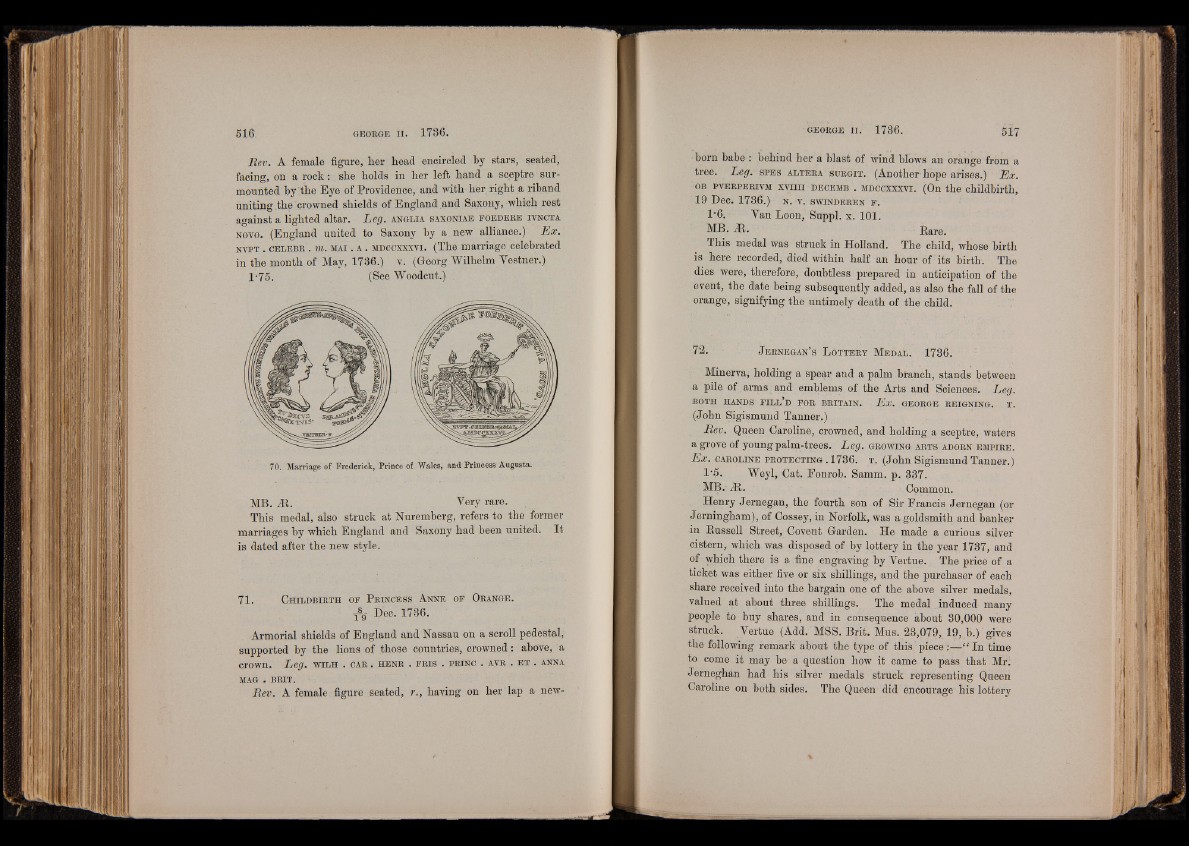
Rev. A female figure, her head encircled by stars, seated,
facing, on a rock : she holds in her left hand a sceptre surmounted
by the Eye of Providence, and with her right a riband
uniting the crowned shields of England and Saxony, which rest
against a lighted altar. Leg. a n g l ia saxoniae f o e d e r e jtvncta
novo. (England united to Saxony by a new alliance.) Ex.
n v p t . c e l e b r . m. m ai . a . mdccxxxvi. (The marriage celebrated
in the month of May, 1786.) v. (Georg Wilhelm Yestner.)
1-75. (See Woodcut.) .
70. Marriage of Frederick, Prince of Wales, and Princess Augusta.
MB. At. Very rare.
This medal, also struck at Nuremberg, refers to the former
marriages by which England and Saxony had been united. It
is dated after the new style.
71. C h il d b ir t h o f P r in c e s s A n n e o f Or a n g e .
^ 9- Bee. 1786.
Armorial shields of England and Nassau on a scroll pedestal,
supported by the lions of those Countries, crowned: above, a
crown. Leg. w il h . car , h e n r . f r i s . p r in c . avr . e t . anna
MAG . BRIT.
Rev. A female figure seated, r., having on her lap a newborn
babe : behind her a blast of wind blows an orange from a
tree. Leg. s p e s a l t e r a s u r g it . (Another hope arises.) Ex.
ob p v e r p e r iv m x v i n i d e c em b . M D e cxxxvr. (On the childbirth,
19 Dec. 178,6.) n . v . sw in d e r e n f .
1*6. Yan Loon, Suppl. x . 101.
MB. At. itare.
This medal was struck in Holland. The child, whose birth
is here recorded, died within half an hour of its birth. The
dies were, therefore, doubtless prepared in anticipation of the
event, the date being subsequently added, as also the fall of the
orange, signifying the untimely death of the child.
72. J e r n e g a n ’s L o t t e r y M e d a l . 1736.
Minerva, holding a spear and a palm branch, stands between
a pile of arms and emblems of the Arts and Sciences. Leg.
BOTH HANDS f i l l ’d FOR BRITAIN. Ex. GEORGE REIGNING. T.
(John Sigismund Tanner.)
Rev. Queen Caroline, crowned, and holding a sceptre, waters
a grove of young palm-trees. Leg. g r ow in g a r t s adorn e m p ir e .
Ex. CAROLINE p r o t e c t in g . 1736. t . (John Sigismund Tanner.)
1*5. Weyl, Cat. Fonrob. Samm. p. 337.
MB. At. Common.
Henry Jernegan, the fourth son of Sir Francis Jernegan (or
Jerningham), of Cossey, in Norfolk, was a goldsmith and banker
in Russell Street, Covent Garden. He made a curious silver
cistern, which was disposed of by lottery in the year 1737, and
of which there is a fine engraving by Yertue. The price of a
ticket was either five or six shillings, and the purchaser of each
share received into the bargain one of the above silver medals,
valued at about three shillings. The medal . induced many
people to buy shares, and in consequence about 30,000 were
struck. Yertue (Add. MSS. Brit. Mus. 23,079,. 19, b.) gives
the following remark about the type of this p i e c e “ In time
to come it may be a question how it came to pass that Mr.
Jerneghan had his silver medals struck representing Queen
Caroline on both sides. The Queen did encourage his lottery